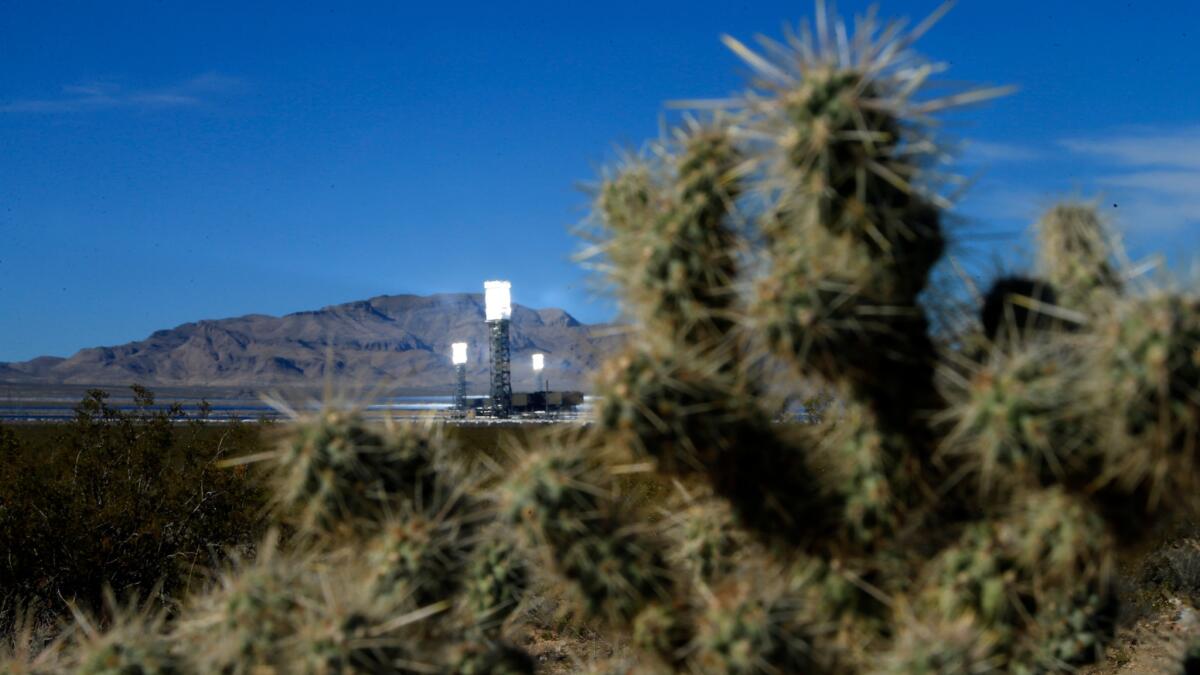Interior Department signs blueprint for renewable energy development in the California desert

For decades, environmentalists have rhapsodized about the tranquil beauty of California’s deserts while battling fiercely with energy companies, the government and within their own ranks over what if any power production should occur on those sun-baked, wind-blown, geothermally active expanses of land.
On Wednesday, U.S. Interior Department officials signed a blueprint that they touted as a finely tuned effort to balance conservation of California’s iconic desert landscapes with the state’s growing hunger for clean energy in the age of climate change.
Eight years in the making, the Desert Renewable Energy Conservation Plan implicitly recognizes that “green” energy can be environmentally destructive.
We’ve all come together in a way that is a path forward for the rest of the nation
— Interior Secretary Sally Jewell
It puts 9.2 million acres of federal land in the California desert off limits to solar, wind and geothermal development, while steering renewable projects to less ecologically valuable areas on about 800,000 acres, with a particular emphasis on roughly half that land.
Projects proposed for Development Focus Areas would enjoy streamlined permitting. Energy development would also be possible on other lands, totaling more than 400,000 acres, but without streamlining.
Increasing the amount of renewable energy produced on federal lands has been a key part of the Obama administration’s climate change policies, which seek to cut fossil fuel use and greenhouse gas emissions.
“You are the epicenter of that here in the Southern California desert,” Interior Secretary Sally Jewell told federal, state, local and tribal officials who had gathered at a signing ceremony in Palm Desert. “We’ve all come together in a way that is a path forward for the rest of the nation.”
Sen. Dianne Feinstein (D-California), who has successfully shepherded major desert protection acts, praised the blueprint.
“The desert’s sweeping desert vistas and rugged mountain terrain provide vital refuge for everything from bighorn sheep and desert tortoises to Joshua Trees and Native American artifacts. The desert likewise holds great potential for utility-scale renewable energy,” Feinstein said in a statement. “We must ensure that the proper balance is struck.”
Several environmental groups also lauded the announcement.
“This plan is a thoughtful and balanced blueprint for the future of the California desert,” said Dan Smuts, senior regional director for the Wilderness Society. “It provides a model for the entire nation by addressing the urgent need for clean energy while protecting important lands for wildlife and plants.”
At least one organization, the Center for Biological Diversity, faulted the Interior Department for not adopting stronger protections. While the document permanently conserves about 2.8 million acres, other lands could be opened to energy development under future plans, warned Ileene Anderson, a senior scientist with the center.
The blueprint, which was the subject of more than 16,000 comments and nearly a dozen public hearings, marks the first part of an effort to map renewable energy development on 22 million acres of the California desert.
The next phase will deal with private holdings in seven desert counties. To date, three counties have pegged 326,750 acres for renewables on nonfederal lands.
The push for renewables by the federal government and California has put the state’s sprawling desert lands in the cross hairs.
Wind turbines, solar panels and geothermal plants are essentially industrial facilities that can kill birds en masse and scrape the desert floor clean of vegetation as well as all the creatures that depend on it.
Some conservation groups have complained that the desert -- a place of spare charms that not all appreciate -- has been turned into a sacrifice zone in the war to slow climate change.
The Ivanpah solar plant west of Las Vegas, for example, is a magnet for insects and the birds that feast on them. Federal biologists say about 6,000 birds a year die from crashes or immolation while chasing flying insects around the facility’s three 40-story towers, which catch sunlight from five square miles of garage-door-size mirrors to drive the plant’s power-producing turbines.
bettina.boxall@latimes.com
Twitter: @boxall
More to Read
Sign up for Essential California
The most important California stories and recommendations in your inbox every morning.
You may occasionally receive promotional content from the Los Angeles Times.











